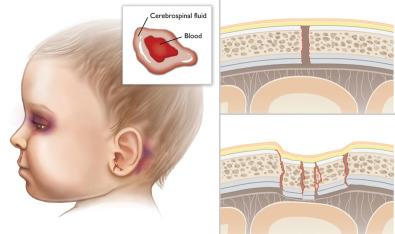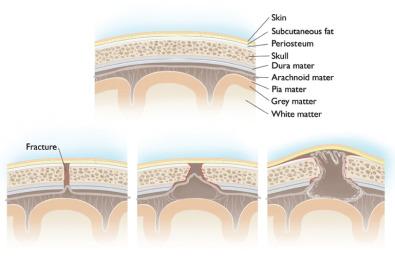Physical Address
304 North Cardinal St.
Dorchester Center, MA 02124
Skull fractures are a common injury in the pediatric population and are often associated with significant morbidity and mortality. A strong foundational knowledge of pediatric skull fractures is essential for appropriate treatment and prevention of long-term complications. Although most skull fractures can be treated with conservative management, timely identification of more severe injuries can be life-saving. The surgeon should be comfortable identifying various fracture patterns and initiating appropriate management for each.
Head trauma is the leading cause of traumatic death in children. It is estimated that more than 600,000 children visit the emergency room each year for blunt head trauma. Of these, 1%–3% will die as a result of intracranial injuries. In the outpatient setting, 2%–20% of children presenting with head trauma will have a skull fracture.
Falls are the most common mechanism of head injury in children, especially under the age of 2, and comprise 35%–54% of cases. Sports-related injuries, peaking between ages 13 to 15 years old, represent another common mechanism of skull fracture and contribute 29% of cases. These patients typically have favorable outcomes and lower rates of mortality. Baseball and softball are the most frequently implicated sports, with the most common mechanism being direct contact between ball and skull. Motor vehicle accidents (MVAs) are the cause of 21%–24% of pediatric skull fractures and increase in prevalence with age. The clinician should have a high suspicion for associated facial, cardiothoracic or cervical spine injuries as the mechanism of injury involves higher energy transfer.
An understanding of the differences between the pediatric and adult skull is important in evaluating fractures and formulating the appropriate management. Thinner bones, a larger head-to-torso ratio, and developing sinuses increase a child's susceptibility to cranial injury. In addition, the retruded position of the face relative to the skull results in a higher incidence of cranial injuries in younger children.
During the first years of life, the pediatric brain and craniofacial skeleton undergo rapid development. At birth, the neurocranium is 25% of its final adult size. It grows to 75% of adult dimensions by age 2 and 95% by age 10. Although the ethmoid and maxillary sinuses are present at birth, both the sphenoidal and frontal sinuses undergo aeration from childhood into puberty. During this period of aeration, frontal fractures become more common. While conservative management is favored prior to frontal sinus aeration in younger patients, teenagers and adults are more often treated operatively.
The parietal bone is the most frequently fractured calvarial bone. These fractures typically occur in younger children, while the incidences of frontal and temporal bone fractures increase with age. Frontal bone fractures can involve the frontal sinus, skull base, and orbit, putting patients at an increased risk for cerebrospinal fluid (CSF) leak and ocular complications. Temporal bone fractures carry the highest risk of mortality, as injury to the underlying middle meningeal artery may lead to an epidural hematoma.
Fracture patterns include linear, comminuted, depressed, open, and growing types ( Figs. 2.1.1 and 2.1.2 ). Each type differs in its presentation and management. Linear fractures, the most common fracture pattern, characteristically arise at the point of maximum impact and spread along the involved bone without crossing suture lines. Comminuted fractures result from higher impact forces and are comprised of multiple associated linear fractures. More significant trauma can result in depressed fractures which are usually associated with underlying cerebral injury and may present as hemorrhage, posttraumatic seizures, or infection. Since open fractures produce a communication between the skull through the scalp or upper respiratory tract, there is an increased risk for central nervous system (CNS) infection. Growing skull fractures are an uncommon late complication of wide skull fractures with underlying dural tear and subsequent brain parenchymal herniation.


A detailed history is essential in evaluating children with head trauma. In the emergency center setting, the AMPLE mnemonic (Allergies, Medications, Past medical history, Last meal, Events surrounding injury) is a useful guide for rapid assessment. Important considerations include the presence of penetrating trauma, intentional injury, and loss of consciousness. Older children may be able to vocalize important aspects of the history, localize pain, and bring other symptoms to attention.
Physical examination begins with a primary survey of the child's airway, breathing, and circulation – the ABCs. The secondary survey should include a head-to-toe examination for soft tissue swelling, hematoma, and palpable skull step-offs, bony irregularity or crepitus. The surgeon should be aware that skull fractures are often associated with underlying intracranial injuries. Independent predictors of intracranial injury include focal neurological deficits, seizures, and altered mental status (AMS); however, not all patients with intracranial injuries will exhibit either skull fractures or focal neurological findings upon initial examination.
Linear fractures most frequently involve the parietal bone and are associated with intracranial injury in 15%–30% of patients. Examination may reveal overlying hematoma or soft tissue swelling, although these findings may require some time to develop. Subgaleal hematomas are largely predictive of underlying skull fractures in infants. Linear fractures of the temporal bone should be evaluated for injury to the middle meningeal artery and subsequent development of an epidural hematoma. Occipital bone fractures may involve the underlying venous sinus and result in hematoma of the posterior fossa.
Comminuted fractures of the occipital bone suggest repeated blows against a solid surface and should raise suspicion for nonaccidental trauma. Diastatic fracture is a term used to describe fractures that traverse suture lines and manifest as widening of the involved suture. This subset of fractures is typically seen in children under the age of 3.
Depressed fractures may be appreciated as palpable step-offs at the site of injury. Of the children with depressed skull fractures, 30% have associated dural or brain injury, with risk of underlying injury directly correlated to the depth of depression. Further complications include hemorrhage, mass effect, ectopic bone fragments, and cosmetic deformity.
Basilar skull fractures often demonstrate unique physical exam findings ( Fig. 2.1.1 ). These include hemotympanum, CSF rhinorrhea or otorrhea, or subcutaneous bleeding over the mastoid process (Battle's sign) or orbit (raccoon eyes or spectacle hematoma). Associated cranial nerve injuries may manifest as hearing loss, facial paralysis, anosmia, vertigo, or tinnitus. Half of these children experience resolution of their deficits while the other half exhibit residual deficiencies. CSF leak is a major complication. Although most leaks resolve spontaneously within a week of injury, 0.7%–5.0% of cases may be complicated by meningitis. Failure of a CSF leak to resolve may necessitate placement of a spinal drain or open repair.
Open fractures result in a communication between the skull and outside environment. A scalp laceration overlying the site of fracture is highly suggestive of an open fracture. Otorrhea, rhinorrhea, or frank CSF present in the wound suggest an underlying dural injury. In cases where bleeding may mask the presence of CSF, a “halo test” can be performed. The patient's dressings can be examined for a lighter ring or “halo” of CSF fluid around blood ( Fig. 2.1.1 ). These patients must be closely monitored for the development of CSF infection.
Dural tears that fail to heal properly may give rise to a “growing skull fracture.” This type of fracture manifests as a slow-growing subcutaneous mass at the fracture site typically detected within the first year after injury ( Fig. 2.1.2 ). Etiologies of this mass include brain herniation, development of a leptomeningeal cyst, or dilation of the ventricles. These fractures are rare and occur mainly in children under 3 who have had suture diastasis, or widening of the skull sutures, greater than 3–4 mm. In one study of 592 consecutive pediatric head injuries, the incidence of growing skull fractures was 1.2%. The most common sites of growing skull fractures are parietal and frontoparietal.
Computed tomography (CT) is the imaging modality of choice to assess skull fractures and intracranial injury. Although all children with presumed head trauma should be considered for CT, imaging is required for patients with AMS, focal neurological deficits, seizures, or a palpable depression. CT should be strongly considered in the case of loss of consciousness, vomiting, headache, drowsiness, amnesia, or when the etiology of trauma is unknown. A low threshold for imaging is employed for infants, as intracranial injuries in this age group may result from minor trauma and manifest with subtle signs and symptoms. The PECARN Pediatric Head Injury/Trauma Algorithm can be used to guide the decision of whether or not to utilize CT imaging.
Skull radiographs are no longer routinely used as meta-analyses have found plain radiographs are neither sensitive nor specific in diagnosing the intracranial injury. Although ultrasonography is becoming increasingly popular in the emergency setting, this technique is operator-dependent and requires advanced training. As technology advances, ultrasound may prove useful in cases when CT is not immediately available.
Become a Clinical Tree membership for Full access and enjoy Unlimited articles
If you are a member. Log in here